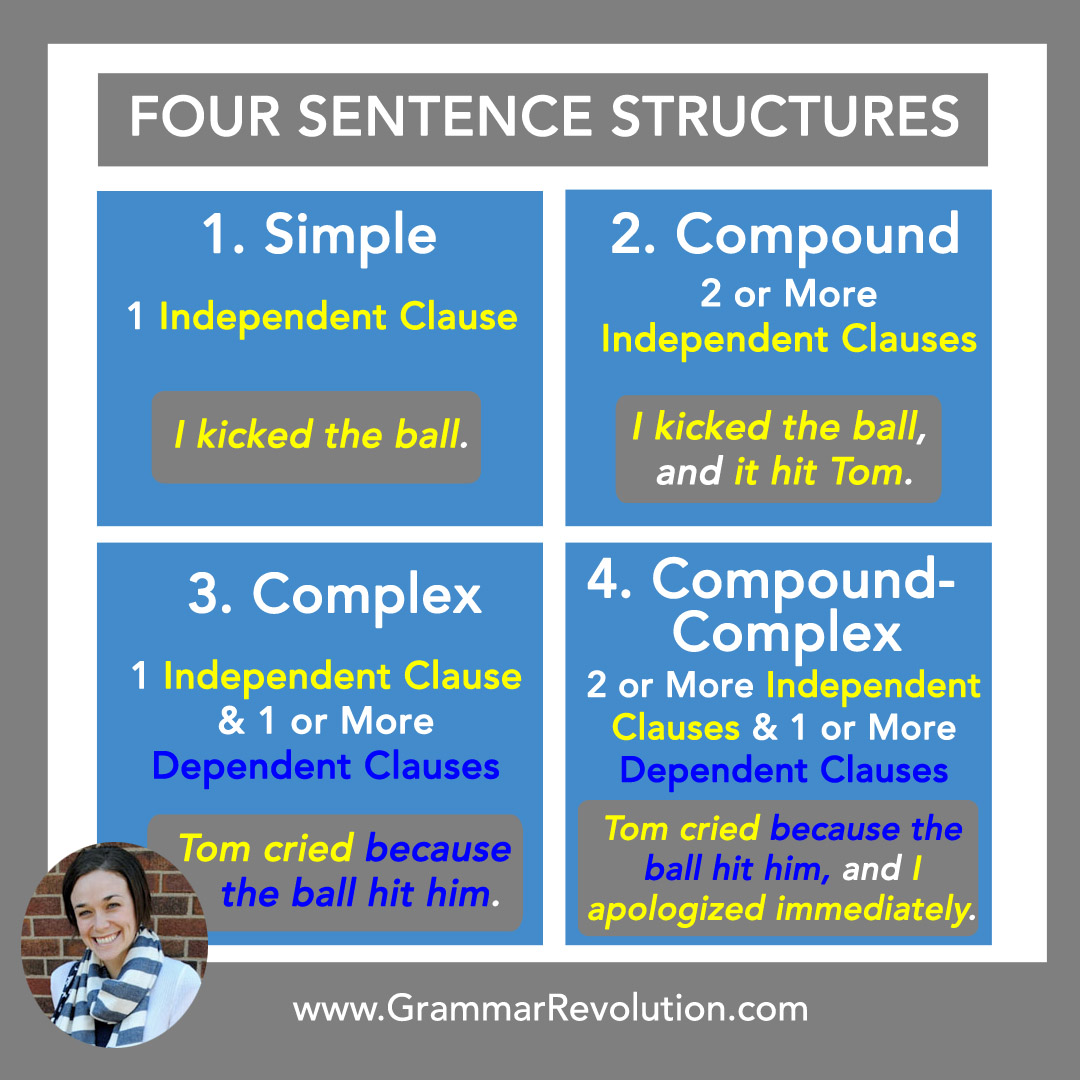
What do you think of when you hear the word structure?
I think of builders and architects planning the parts of a building and figuring out how all of the elements will fit together in the final product.
You and I might not build buildings, but we do build sentences. We can think of ourselves as word architects, and word architects need to study sentence structure so that they know what possibilities sentences hold.
That way, we can learn to vary our sentences, which will make our writing more engaging, and we can make sure that our sentences are grammatically correct.
But before we get to studying sentence structure, have you ever stopped to think about what a sentence actually is?
A sentence is a group of words, with both a subject and a verb, that expresses a complete thought. Sentences make it easy to understand ideas and learn information.
We can categorize sentences based on different criteria, and one way to categorize them is based on their structure.

When I say that we're looking at a sentence's structure, what we're really looking at is what combination of independent clauses and dependent clauses a sentence has. Because of that, it's important that you know a little bit about clauses before we get started.
Clauses are groups of words with both a subject and a verb. There are two main types of clauses.
I teach grammar is an independent clause. It contains a subject (I), a verb (teach), and it expresses a complete thought.
Because I teach grammar is a dependent clause. It contains a subject ( I ), a verb ( teach ), and it does not express a complete thought.
Okay. back to sentence structure.
When we categorize sentences based on structure (different combinations of independent and dependent clauses), we find that there are four sentence structures. Let's learn about each one!
A simple sentence contains only one independent clause.
I kicked the ball.
Remember that an independent clause is a group of words that has both a subject and a verb, and expresses a complete thought.
I'll use sentence diagrams to show you what these different sentence structures look like because the diagrams really SHOW you the different structures! Here is a sentence diagram of a simple sentence. Note that there is only one horizontal line.

Let's look at something that can cause confusion: simple sentences contain one subject and verb, but both or either of those things can be compound. ("Compound" means that something is made up of two or more elements.)
Look at the diagram below and note that the sentence has a compound subject (Lewis, Alice) and a compound verb (played, read).
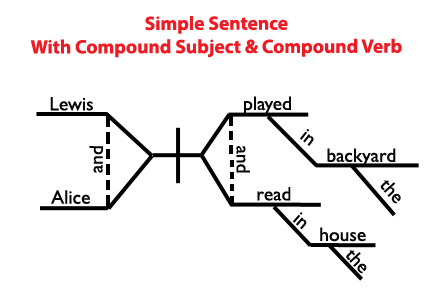
Lewis and Alice played in the backyard and read in the house.
In the diagram above, the compound elements are on separate horizontal lines, but there is just one spot where the main horizontal line meets the vertical line. This shows us that it's still a simple sentence; it just has compound elements.
Speaking of compound things, let's learn about compound sentences!
A compound sentence contains at least two independent clauses.
I kicked the ball, and it hit Tom.
These clauses are joined by a coordinating conjunction or a semicolon. (When you join two independent clauses with only a comma, it's a mistake called a comma splice.)
A coordinating conjunction (for, and, nor, but, or, yet, so) is a word that glues sentence elements (words, phrases, clauses) together that are the same.
Here's a sentence diagram of a compound sentence. Note that there are now two horizontal lines, and one is directly below the other.

I kicked the ball, and it hit Tom.
Remember that some sentences (Jeremy and I kicked the ball.) might seem like they're compound if they have compound elements (Jeremy and I), but they're actually simple.
Psst! Did you know?
In order to be a complete sentence, a group of words needs to contain a subject and a verb, and it needs to express a complete thought.
If a group of words is missing any of that information, it's probably a sentence fragment, and if you have a group of words containing two or more independent clauses that are not properly punctuated, it's probably a run-on sentence.
A complex sentence contains a subordinate clause and an independent clause.
Tom cried because the ball hit him.
A subordinate clause is a group of words that has a subject and a verb but does not express a complete thought.
Here's a sentence diagram of a complex sentence. Note that there are still two horizontal lines, but one of them is below the other and moved to the right.
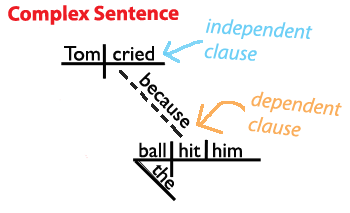
Tom cried because the ball hit him.
Sometimes, it can be hard for people to tell the difference between compound sentences and complex sentences, and a sentence's structures can be changed by swapping out just one word! You can learn more about that here.
A compound-complex sentence is just what it seems like it would be. :) It's basically a combination of a compound sentence and a complex sentence. You know what that means, right? It means that these guys contain at least two independent clauses and at least one subordinate clause.
Tom cried because the ball hit him, and I apologized immediately.
Here's a diagram of a compound-complex sentence. Note that it's a hybrid of a compound sentence and a complex sentence! Two of the horizontal lines are directly above and below each other and the third is hanging out there in the middle.
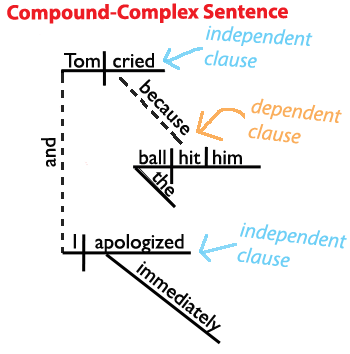
Tom cried because the ball hit him, and I apologized immediately.
Now you have a great understanding of sentence structure! Be sure to sign up for our free bi-weekly newsletter so that we can keep in touch!
Okay, now you know about simple, compound, complex, and compound-complex sentences, but you might be wondering why this information is even important. Here are 9 things understanding sentence structure will do help you do:
Even if you don't know how to punctuate a particular sentence, understanding sentence structure allows you to search for the right answer. For example, if you know sentence structure, but you're unsure of punctuation rules, you might perform the following searches:
- Do I add a comma after an introductory adverb clause?
- Does a noun clause acting as the subject of a sentence need a comma after it?
But, in order to create relevant searches, you would need to know what about sentence structure!
Understanding sentence structure empowers you to effectively express your thoughts and have meaningful conversations. It's a fundamental skill that supports thinking, reading, and writing!
Let's review what we covered on this page!

Hello! I'm Elizabeth O'Brien, and my goal is to get you jazzed about grammar.
If you'd like to teach or learn grammar the easy way—with sentence diagrams—check out our Get Smart Grammar Program.
It starts from the very beginning and teaches you grammar and sentence diagramming in easy, bite-size lessons.
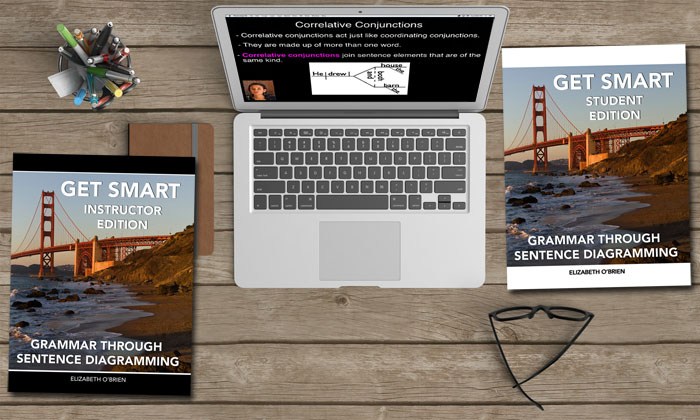
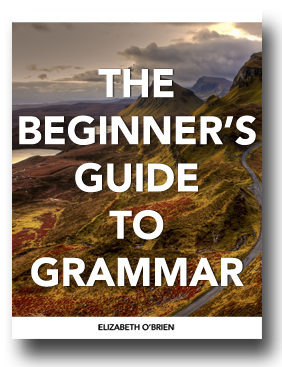
Our Free Guide Gives You A Fun Way
To Teach And Learn The Basics v
Elizabeth O'Brien is the creator of Grammar Revolution.
Her lessons are guaranteed to give you more confidence in your communication skills and make you smile. :)